2014 MERCEDES-BENZ S-CLASS COUPE brake light
[x] Cancel search: brake lightPage 308 of 413
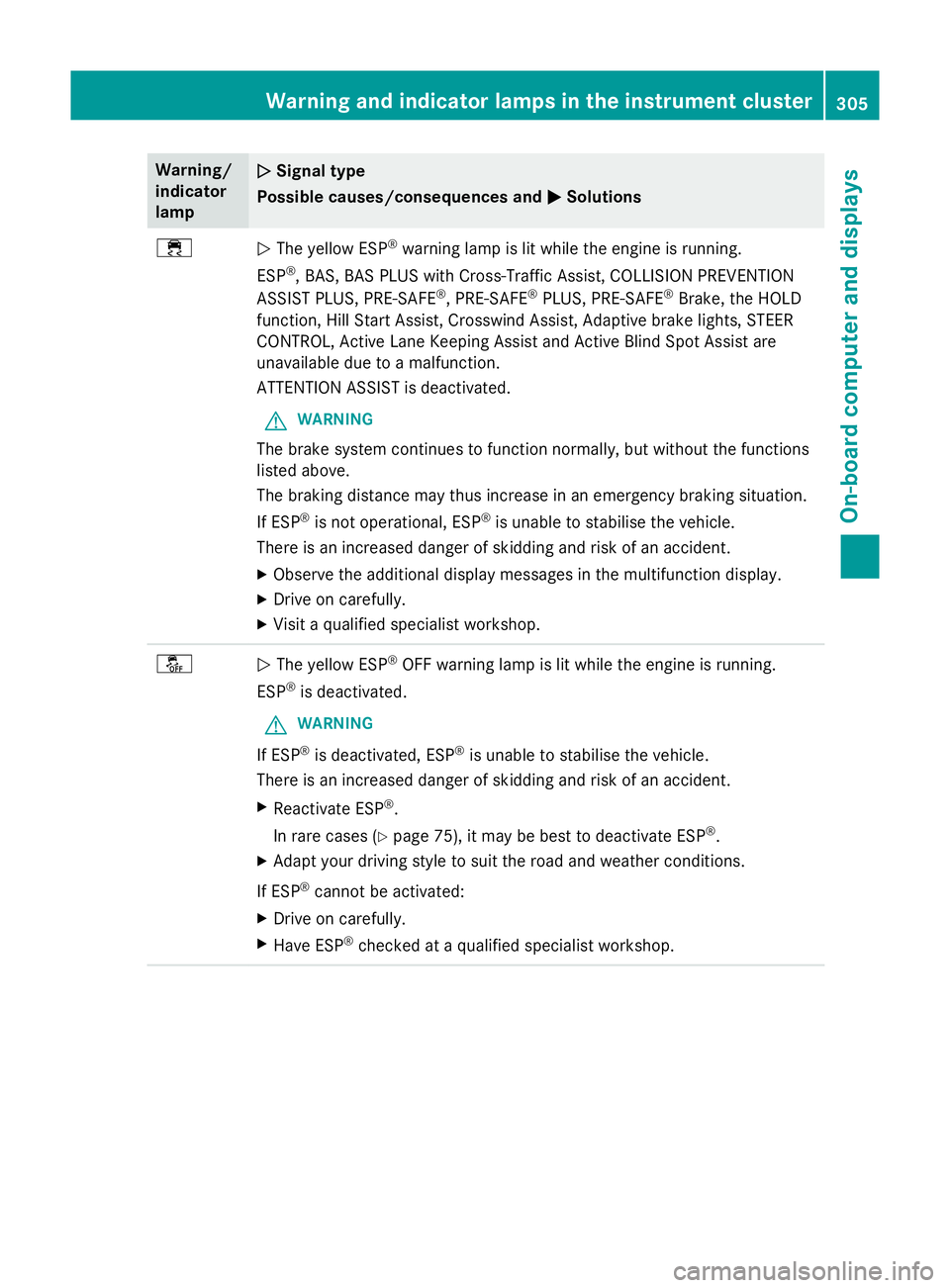
Warning/
indicator
lamp
N N
Signal type
Possible causes/consequences and M
MSolutions ÷
N
The yellow ESP ®
warning lamp is lit while the engine is running.
ESP ®
, BAS, BAS PLUS with Cross-Traffic Assist, COLLISION PREVENTION
ASSIST PLUS, PRE ‑SAFE®
, PRE‑SAFE ®
PLUS, PRE‑SAFE ®
Brake, the HOLD
function, Hill Start Assist, Crosswind Assist, Adaptive brake lights, STEER
CONTROL, Active Lane Keeping Assist and Active Blind Spot Assist are
unavailable due to a malfunction.
ATTENTION ASSIST is deactivated.
G WARNING
The brake system continues to function normally, but without the functions
listed above.
The braking distance may thus increase in an emergency braking situation.
If ESP ®
is not operational, ESP ®
is unable to stabilise the vehicle.
There is an increased danger of skidding and risk of an accident.
X Observe the additional display messages in the multifunction display.
X Drive on carefully.
X Visit a qualified specialist workshop. å
N
The yellow ESP ®
OFF warning lamp is lit while the engine is running.
ESP ®
is deactivated.
G WARNING
If ESP ®
is deactivated, ESP ®
is unable to stabilise the vehicle.
There is an increased danger of skidding and risk of an accident.
X Reactivate ESP ®
.
In rare cases (Y page 75), it may be best to deactivate ESP ®
.
X Adapt your driving style to suit the road and weather conditions.
If ESP ®
cannot be activated:
X Drive on carefully.
X Have ESP ®
checked at a qualified specialist workshop. Warning and indicator lamps in the instrument cluster
305On-board computer and displays Z
Page 312 of 413
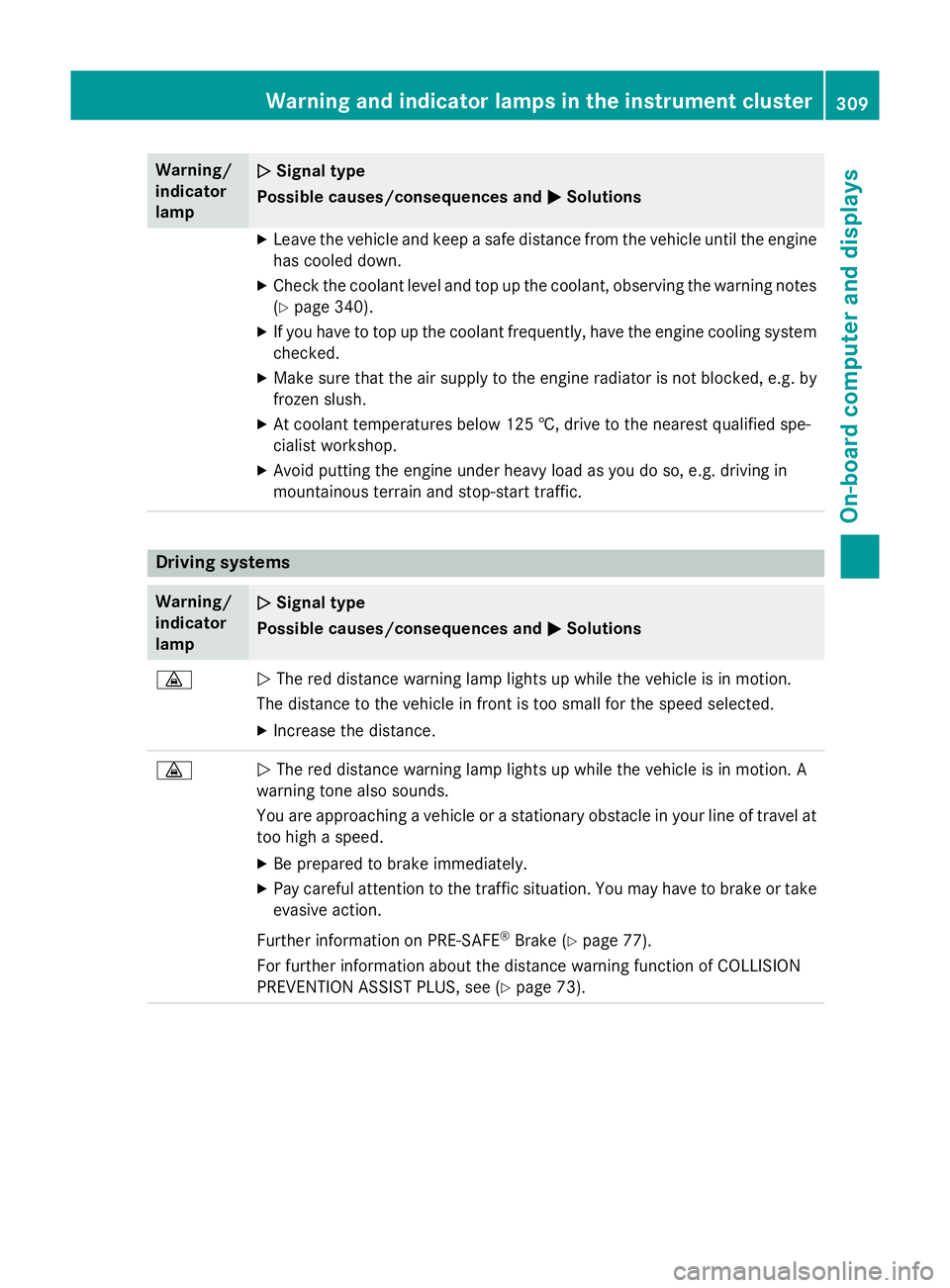
Warning/
indicator
lamp
N N
Signal type
Possible causes/consequences and M
MSolutions X
Leave the vehicle and keep a safe distance from the vehicle until the engine
has cooled down.
X Check the coolant level and top up the coolant, observing the warning notes
(Y page 340).
X If you have to top up the coolant frequently, have the engine cooling system
checked.
X Make sure that the air supply to the engine radiator is not blocked, e.g. by
frozen slush.
X At coolant temperatures below 125 †, drive to the nearest qualified spe-
cialist workshop.
X Avoid putting the engine under heavy load as you do so, e.g. driving in
mountainous terrain and stop-start traffic. Driving systems
Warning/
indicator
lamp
N N
Signal type
Possible causes/consequences and M
MSolutions ·
N
The red distance warning lamp lights up while the vehicle is in motion.
The distance to the vehicle in front is too small for the speed selected.
X Increase the distance. ·
N
The red distance warning lamp lights up while the vehicle is in motion. A
warning tone also sounds.
You are approaching a vehicle or a stationary obstacle in your line of travel at too high a speed.
X Be prepared to brake immediately.
X Pay careful attention to the traffic situation. You may have to brake or take
evasive action.
Further information on PRE ‑SAFE®
Brake (Y page 77).
For further information about the distance warning function of COLLISION
PREVENTION ASSIST PLUS, see (Y page 73). Warning and indicator lamps in the instrument cluster
309On-board computer and displays Z
Page 349 of 413

X
Soak bird droppings with water and rinse
off the treated areas afterwards.
X Remove coolant, brake fluid, tree resin,
oils, fuels and greases by rubbing gently
with a cloth soaked in petroleum ether or
lighter fluid.
X Use tar remover to remove tar stains.
X Use silicone remover to remove wax.
Care and treatment of matt paintwork !
Never polish the vehicle or the light alloy
wheels. Polishing makes the paintwork
shiny.
! The following may cause the paint to
become shiny and thus reduce the matt
effect:
R Vigorous rubbing with unsuitable mate-
rials.
R Frequent use of car washes.
R Washing the vehicle in direct sunlight.
! Never use paint cleaner, buffing or pol-
ishing products, or gloss preserver, e.g.
wax. These products are only suitable for
high-gloss surfaces. Their use on vehicles
with matt finish leads to considerable sur-
face damage (shiny, spotted areas).
Always have paintwork repairs carried out
at a qualified specialist workshop.
! Do not use wash programs with a hot wax
treatment under any circumstances.
Observe these notes if your vehicle has a
clear matt finish. This will help you to avoid
damage to the paintwork due to incorrect
treatment.
These notes also apply to light-alloy wheels
with a clear matt finish.
The vehicle should preferably be washed by
hand using a soft sponge, car shampoo and
plenty of water.
Use only insect remover and car shampoo
from the range of approved Mercedes-Benz
care products. Cleaning vehicle parts
Cleaning the wheels !
Do not use acidic wheel cleaning products
to remove brake dust. This could damage
wheel bolts and brake components.
! Do not park up the vehicle for an extended
period straight after cleaning it, particularly after having cleaned the wheels with wheel cleaner. Wheel cleaners could cause
increased corrosion of the brake discs and
brake pads/linings. For this reason, you
should drive for a few minutes after clean-
ing. Braking heats the brake discs and the
brake pads/linings, thus drying them. The
vehicle can then be parked up.
Cleaning the windows G
WARNING
If the windscreen wipers are set in motion
when cleaning the windscreen or wiper
blades, you could become trapped. There is a danger of injury.
Always switch off the windscreen wipers and
the ignition before cleaning the windscreen orwiper blades.
! Do not use dry cloths, abrasive products,
solvents or cleaning agents containing sol- vents to clean the inside of the windows. Do
not touch the insides of the windows with
hard objects, e.g. an ice scraper or ring.
There is otherwise a risk of damaging the
windows.
! Clean the water drainage channels of the
windscreen and the rear window at regular
intervals. Deposits such as leaves, petals
and pollen may under certain circumstan-
ces prevent water from draining away. This
can lead to corrosion damage and damage to electronic components.
X Clean the inside and outside of the win-
dows with a damp cloth and a cleaning
agent that is recommended and approved
by Mercedes-Benz. 346
CareMaintenance and care
Page 368 of 413
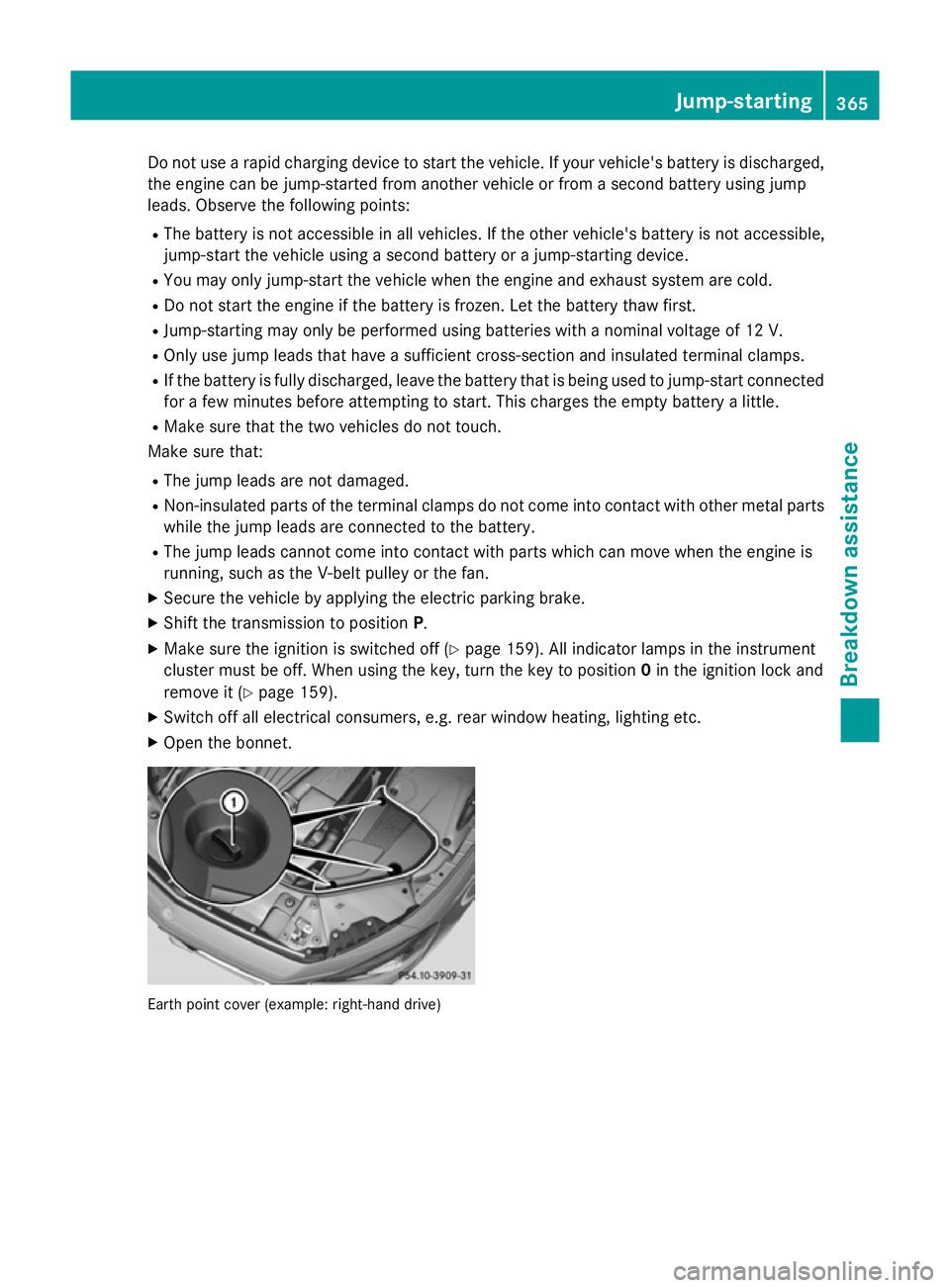
Do not use a rapid charging device to start the vehicle. If your vehicle's battery is discharged,
the engine can be jump-started from another vehicle or from a second battery using jump
leads. Observe the following points:
R The battery is not accessible in all vehicles. If the other vehicle's battery is not accessible,
jump-start the vehicle using a second battery or a jump-starting device.
R You may only jump-start the vehicle when the engine and exhaust system are cold.
R Do not start the engine if the battery is frozen. Let the battery thaw first.
R Jump-starting may only be performed using batteries with a nominal voltage of 12 V.
R Only use jump leads that have a sufficient cross-section and insulated terminal clamps.
R If the battery is fully discharged, leave the battery that is being used to jump-start connected
for a few minutes before attempting to start. This charges the empty battery a little.
R Make sure that the two vehicles do not touch.
Make sure that:
R The jump leads are not damaged.
R Non-insulated parts of the terminal clamps do not come into contact with other metal parts
while the jump leads are connected to the battery.
R The jump leads cannot come into contact with parts which can move when the engine is
running, such as the V-belt pulley or the fan.
X Secure the vehicle by applying the electric parking brake.
X Shift the transmission to position P.
X Make sure the ignition is switched off (Y page 159). All indicator lamps in the instrument
cluster must be off. When using the key, turn the key to position 0in the ignition lock and
remove it (Y page 159).
X Switch off all electrical consumers, e.g. rear window heating, lighting etc.
X Open the bonnet. Earth point cover (example: right-hand drive) Jump-starting
365Breakdown assistance Z
Page 398 of 413
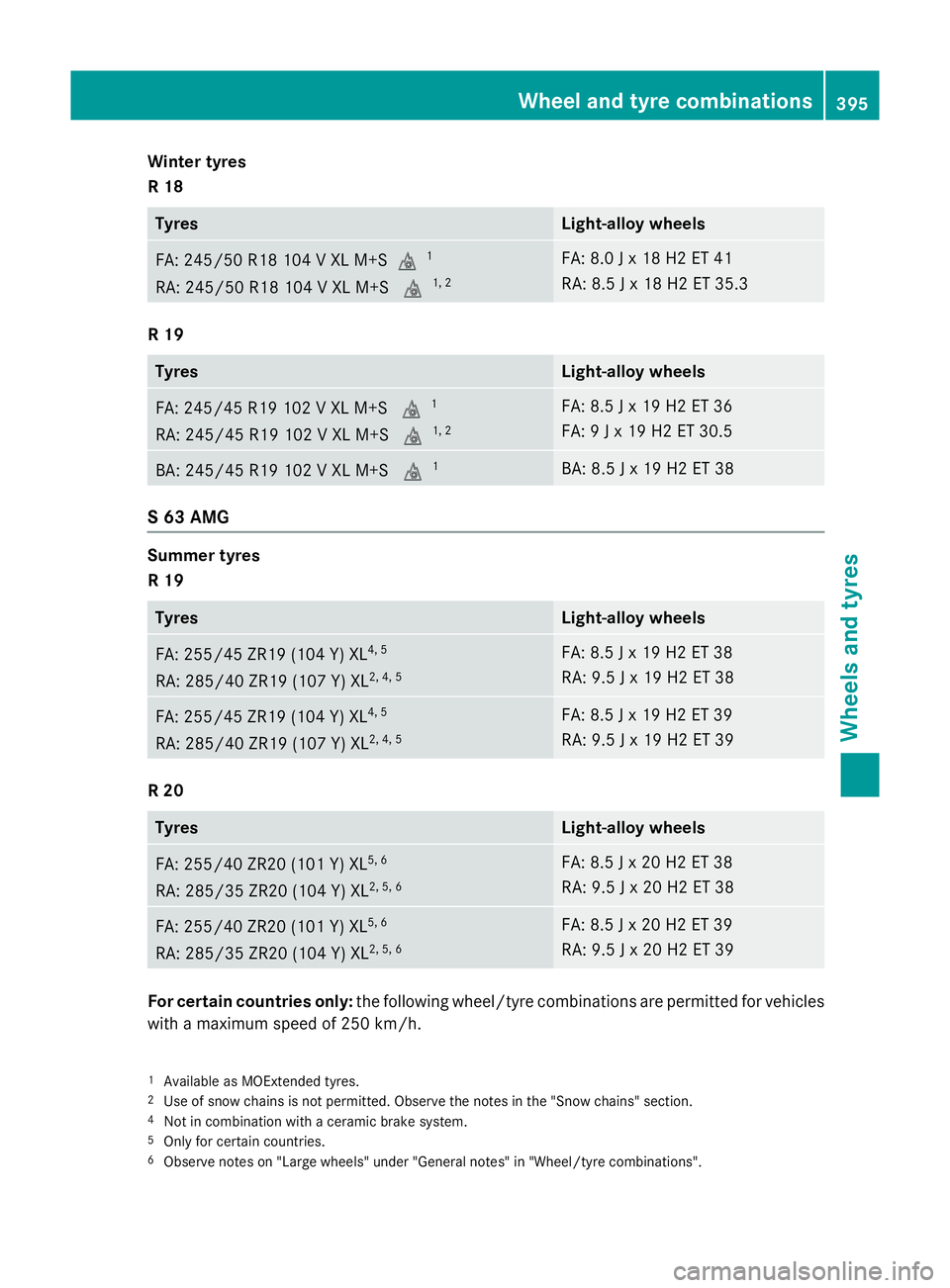
Winter tyres
R 18
Tyres Light-alloy wheels
FA: 245/50 R18 104 V XL M+Si
1
RA: 245/50 R18 104 V XL M+S i1, 2 FA: 8.0 J x 18 H2 ET 41
RA: 8.5 J x 18 H2 ET 35.3
R 19
Tyres Light-alloy wheels
FA: 245/45 R19 102 V XL M+S
i1
RA: 245/45 R19 102 V XL M+S i1, 2 FA: 8.5 J x 19 H2 ET 36
FA: 9 J x 19 H2 ET 30.5
BA: 245/45 R19 102 V XL M+S
i1 BA: 8.5 J x 19 H2 ET 38
S 63 AMG
Summer tyres
R 19
Tyres Light-alloy wheels
FA: 255/45 ZR19 (104 Y) XL
4, 5
RA: 285/40 ZR19 (107 Y) XL 2, 4, 5 FA: 8.5 J x 19 H2 ET 38
RA: 9.5 J x 19 H2 ET 38
FA: 255/45 ZR19 (104 Y) XL
4, 5
RA: 285/40 ZR19 (107 Y) XL 2, 4, 5 FA: 8.5 J x 19 H2 ET 39
RA: 9.5 J x 19 H2 ET 39
R 20
Tyres Light-alloy wheels
FA: 255/40 ZR20 (101 Y) XL
5, 6
RA: 285/35 ZR20 (104 Y) XL 2, 5, 6 FA: 8.5 J x 20 H2 ET 38
RA: 9.5 J x 20 H2 ET 38
FA: 255/40 ZR20 (101 Y) XL
5, 6
RA: 285/35 ZR20 (104 Y) XL 2, 5, 6 FA: 8.5 J x 20 H2 ET 39
RA: 9.5 J x 20 H2 ET 39
For certain countries only:
the following wheel/tyre combinations are permitted for vehicles
with a maximum speed of 250 km/h.
1 Available as MOExtended tyres.
2 Use of snow chains is not permitted. Observe the notes in the "Snow chains" section.
4 Not in combination with a ceramic brake system.
5 Only for certain countries.
6 Observe notes on "Large wheels" under "General notes" in "Wheel/tyre combinations". Wheel and tyre combinations
395Wheels and tyres Z
Page 399 of 413
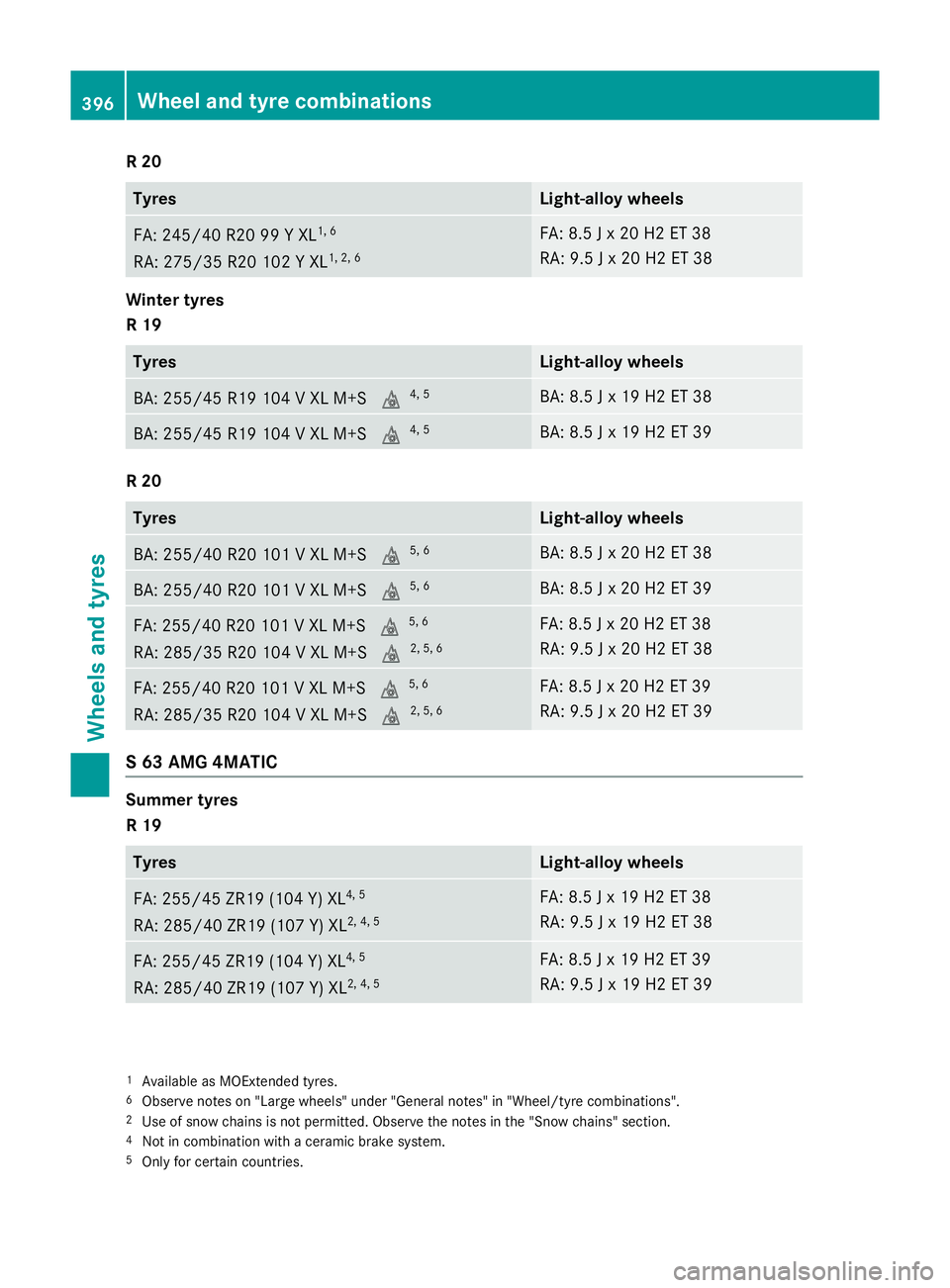
R 20
Tyres Light-alloy wheels
FA: 245/40 R20 99 Y XL
1, 6
RA: 275/35 R20 102 Y XL 1, 2, 6 FA: 8.5 J x 20 H2 ET 38
RA: 9.5 J x 20 H2 ET 38
Winter tyres
R 19
Tyres Light-alloy wheels
BA: 255/45 R19 104 V XL M+S
i4, 5 BA: 8.5 J x 19 H2 ET 38
BA: 255/45 R19 104 V XL M+S
i4, 5 BA: 8.5 J x 19 H2 ET 39
R 20
Tyres Light-alloy wheels
BA: 255/40 R20 101 V XL M+S
i5, 6 BA: 8.5 J x 20 H2 ET 38
BA: 255/40 R20 101 V XL M+S
i5, 6 BA: 8.5 J x 20 H2 ET 39
FA: 255/40 R20 101 V XL M+S
i5, 6
RA: 285/35 R20 104 V XL M+S i2, 5, 6 FA: 8.5 J x 20 H2 ET 38
RA: 9.5 J x 20 H2 ET 38
FA: 255/40 R20 101 V XL M+S
i5, 6
RA: 285/35 R20 104 V XL M+S i2, 5, 6 FA: 8.5 J x 20 H2 ET 39
RA: 9.5 J x 20 H2 ET 39
S 63 AMG 4MATIC
Summer tyres
R 19
Tyres Light-alloy wheels
FA: 255/45 ZR19 (104 Y) XL
4, 5
RA: 285/40 ZR19 (107 Y) XL 2, 4, 5 FA: 8.5 J x 19 H2 ET 38
RA: 9.5 J x 19 H2 ET 38
FA: 255/45 ZR19 (104 Y) XL
4, 5
RA: 285/40 ZR19 (107 Y) XL 2, 4, 5 FA: 8.5 J x 19 H2 ET 39
RA: 9.5 J x 19 H2 ET 39
1
Available as MOExtended tyres.
6 Observe notes on "Large wheels" under "General notes" in "Wheel/tyre combinations".
2 Use of snow chains is not permitted. Observe the notes in the "Snow chains" section.
4 Not in combination with a ceramic brake system.
5 Only for certain countries. 396
Wheel and tyre combinationsWheels and tyres
Page 400 of 413

R 20
Tyres Light-alloy wheels
FA: 255/40 ZR20 (101 Y) XL
5, 6
RA: 285/35 ZR20 (104 Y) XL 2, 5, 6 FA: 8.5 J x 20 H2 ET 38
RA: 9.5 J x 20 H2 ET 38
FA: 255/40 ZR20 (101 Y) XL
5, 6
RA: 285/35 ZR20 (104 Y) XL 2, 5, 6 FA: 8.5 J x 20 H2 ET 39
RA: 9.5 J x 20 H2 ET 39
For certain countries only:
the following wheel/tyre combinations are permitted for vehicles
with a maximum speed of 250 km/h.
R 20 Tyres Light-alloy wheels
FA: 245/40 R20 99 Y XL
1, 6
RA: 275/35 R20 102 Y XL 1, 2, 6 FA: 8.5 J x 20 H2 ET 38
RA: 9.5 J x 20 H2 ET 38
Winter tyres
R 19
Tyres Light-alloy wheels
BA: 255/45 R19 104 V XL M+S
i4, 5 BA: 8.5 J x 19 H2 ET 38
BA: 255/45 R19 104 V XL M+S
i4, 5 BA: 8.5 J x 19 H2 ET 39
R 20
Tyres Light-alloy wheels
BA: 255/40 R20 101 V XL M+S
i5, 6 BA: 8.5 J x 20 H2 ET 38
BA: 255/40 R20 101 V XL M+S
i5, 6 BA: 8.5 J x 20 H2 ET 39
FA: 255/40 R20 101 V XL M+S
i5, 6
RA: 285/35 R20 104 V XL M+S i2, 5, 6 FA: 8.5 J x 20 H2 ET 38
RA: 9.5 J x 20 H2 ET 38
FA: 255/40 R20 101 V XL M+S
i5, 6
RA: 285/35 R20 104 V XL M+S i2, 5, 6 FA: 8.5 J x 20 H2 ET 39
RA: 9.5 J x 20 H2 ET 39
5
Only for certain countries.
6 Observe notes on "Large wheels" under "General notes" in "Wheel/tyre combinations".
2 Use of snow chains is not permitted. Observe the notes in the "Snow chains" section.
1 Available as MOExtended tyres.
4 Not in combination with a ceramic brake system. Wheel and tyre combinations
397Wheels and tyres Z